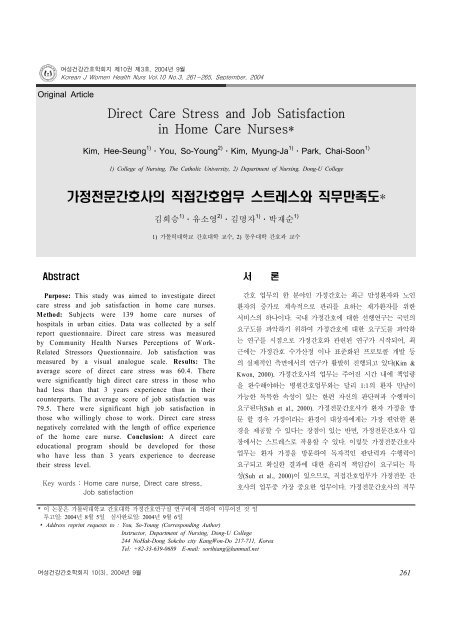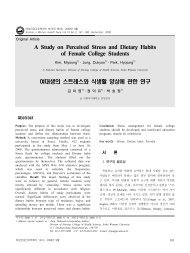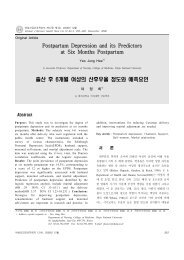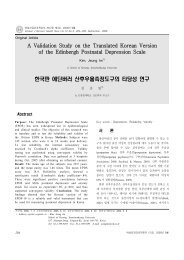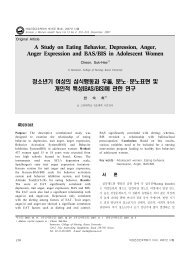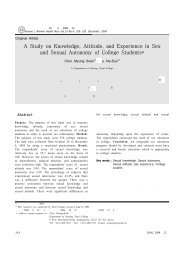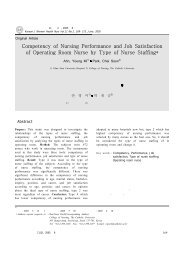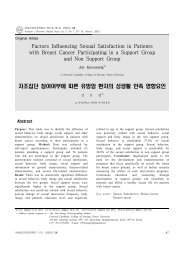Direct Care Stress and Job Satisfaction in Home Care Nurses* ê°ì ...
Direct Care Stress and Job Satisfaction in Home Care Nurses* ê°ì ...
Direct Care Stress and Job Satisfaction in Home Care Nurses* ê°ì ...
Create successful ePaper yourself
Turn your PDF publications into a flip-book with our unique Google optimized e-Paper software.
여성건강간호학회지 제10권 제3호, 2004년 9월Korean J Women Health Nurs Vol.10 No.3, 261-265, September, 2004Orig<strong>in</strong>al Article<strong>Direct</strong> <strong>Care</strong> <strong>Stress</strong> <strong>and</strong> <strong>Job</strong> <strong>Satisfaction</strong><strong>in</strong> <strong>Home</strong> <strong>Care</strong> <strong>Nurses*</strong>Kim, Hee-Seung 1) ․You, So-Young 2) ․Kim, Myung-Ja 1) ․Park, Chai-Soon 1)1) College of Nurs<strong>in</strong>g, The Catholic University, 2) Department of Nurs<strong>in</strong>g, Dong-U College가정전문간호사의 직접간호업무 스트레스와 직무만족도*김희승 1) ․유소영 2) ․김명자 1) ․박재순 1)1) 가톨릭대학교 간호대학 교수, 2) 동우대학 간호과 교수Abstract서론Purpose: This study was aimed to <strong>in</strong>vestigate directcare stress <strong>and</strong> job satisfaction <strong>in</strong> home care nurses.Method: Subjects were 139 home care nurses ofhospitals <strong>in</strong> urban cities. Data was collected by a selfreport questionnaire. <strong>Direct</strong> care stress was measuredby Community Health Nurses Perceptions of Work-Related <strong>Stress</strong>ors Questionnaire. <strong>Job</strong> satisfaction wasmeasured by a visual analogue scale. Results: Theaverage score of direct care stress was 60.4. Therewere significantly high direct care stress <strong>in</strong> those whohad less than that 3 years experience than <strong>in</strong> theircounterparts. The average score of job satisfaction was79.5. There were significant high job satisfaction <strong>in</strong>those who will<strong>in</strong>gly chose to work. <strong>Direct</strong> care stressnegatively correlated with the length of office experienceof the home care nurse. Conclusion: A direct careeducational program should be developed for thosewho have less than 3 years experience to decreasetheir stress level.Key words : <strong>Home</strong> care nurse, <strong>Direct</strong> care stress,<strong>Job</strong> satisfaction간호 업무의 한 분야인 가정간호는 최근 만성환자와 노인환자의 증가로 계속적으로 관리를 요하는 재가환자를 위한서비스의 하나이다. 국내 가정간호에 대한 선행연구는 국민의요구도를 파악하기 위하여 가정간호에 대한 요구도를 파악하는 연구를 시점으로 가정간호와 관련된 연구가 시작되어, 최근에는 가정간호 수가산정 이나 표준화된 프로토콜 개발 등의 실제적인 측면에서의 연구가 활발히 진행되고 있다(Kim &Kwon, 2000). 가정간호사의 업무는 주어진 시간 내에 책임량을 완수해야하는 병원간호업무와는 달리 1:1의 환자 만남이가능한 독특한 속성이 있는 한편 자신의 판단력과 수행력이요구된다(Suh et al., 2000). 가정전문간호사가 환자 가정을 방문 할 경우 가정이라는 환경이 대상자에게는 가장 편안한 환경을 제공할 수 있다는 장점이 있는 반면, 가정전문간호사 입장에서는 스트레스로 작용할 수 있다. 이렇듯 가정전문간호사업무는 환자 가정을 방문하여 독자적인 판단력과 수행력이요구되고 확실한 결과에 대한 윤리적 책임감이 요구되는 특성(Suh et al., 2000)이 있으므로, 직접간호업무가 가정전문 간호사의 업무중 가장 중요한 업무이다. 가정전문간호사의 직무* 이 논문은 가톨릭대학교 간호대학 가정간호연구실 연구비에 의하여 이루어진 것 임투고일: 2004년 8월 5일 심사완료일: 2004년 9월 6일∙ Address repr<strong>in</strong>t requests to : You, So-Young (Correspond<strong>in</strong>g Author)Instructor, Department of Nurs<strong>in</strong>g, Dong-U College244 NoHak-Dong Sokcho city KangWon-Do 217-711, KoreaTel: +82-33-639-0689 E-mail: sorihiang@hanmail.net여성건강간호학회지 10(3), 2004년 9월 261
김희승․유소영 외스트레스 중에서 ‘환자직접간호업무’ 요인이 가장 스트레스가높은 것으로 보고되고 있다(Yoon, 2003). 가정전문간호사 업무중 직접간호업무 는 환자에게 직접 제공되는 간호행위로Park과 Cho(1992)는 간호영역을 16개로 나누어 호흡, 영양섭취, 배설, 운동 및 자세변경, 수면과 휴식, 침상정리 및 환의교환, 체온유지, 개인위생, 안전간호, 의사소통 및 지지, 영적간호, 성취감, 여가활동, 상담 및 교육, 투약, 측정 및 관찰로분류한 연구도 있다.그동안 간호사 스트레스에 관한 연구로는 수술실(Lee,1998), 중환자실(Choi, 1998), 정신과 병동(Kim, 1995), 응급실(Park & Koh, 1999), 한방병원(Choi, 1999) 및 손해보험회사(Chung, 2001)가 있으나 가정전문간호사 직접간호업무스트레스를 조사한 연구는 드물었다.한편 직무만족(job satisfaction)은 개인의 태도와 가치, 신념,욕구 등의 수준에 따라 직무자체를 비롯한 직무환경에 대한평가에서 얻어지는 유쾌한 감정적, 정서적 만족상태이며(Locke, 1976), 직장에 대한 정서적, 정신적 반응이다(Kimball,1975). 그동안 지역사회에서 일하는 간호사의 직무만족도에관한 연구로는 보건진료원(Suk, 1993; Lee & Park, 1999), 보건소 간호사(Oh, 1987; Yang, 1997; Lee & Kim, 2000)를 대상으로 이루어졌으나 가정전문간호사를 대상으로 직무만족도를 조사한 연구는 드물었다.이에 본 연구자는 가정전문간호사의 직접간호업무 스트레스와 직무만족도의 실태를 파악하고 그 상관관계를 알아보고자본 연구를 실시하였다.연구 목적가정전문간호사의 직접간호업무 스트레스와 직무만족도를파악하고 그 상관관계를 보고자 실시되었으며, 구체적인 목적은 다음과 같다.첫째, 가정전문간호사의 직접간호업무 스트레스를 조사한다.둘째, 가정전문간호사의 직무만족도를 파악한다.셋째, 업무 스트레스와 직무만족도와의 상관관계를 분석한다.연구 방법1. 연구 설계본 연구는 가정전문간호사의 직접간호업무 스트레스와 직무만족도를 파악하기 위한 서술적 조사연구이다.2. 연구 대상2003년 4월 현재 가정간호사회에 등록된 전국 89개 가정간호사업소 전수의 가정간호사 233명 중 연구 참여에 동의한73개 병원 가정간호사 139명이었다.3. 연구 도구1) 업무스트레스 측정도구CHN-PWRSQ(Community Health Nurses Perceptions ofWork-Related <strong>Stress</strong>ors Questionnaire)(Walcott-McQuigg, 1992)67문항 중 직접간호업무에 해당되는 영역의 18문항을 발췌하였다. 직접간호업무에 해당하는 18문항은 석사이상의 학위를가진 간호대학 교수 3인, 가정전문간호사 2인의 내용의 타당도를 검정 받았다. 선정된 18문항은 비협조적인 환자가족,비협조적인 환자, 중증도가 높은 환자 간호, 특별히 의미 있는 환자의 죽음, 환자 간호 시 발생하는 응급상황 등 의사결정에 대한 책임, 전염성 질환에의 노출, 회복 불가능한 환자의 간호, 임종을 앞둔 환자 간호, 죽음에 대해 환자와 대화하기, 환자의 정서적 욕구를 충족시킬 수 있는 능력 부족, 환자가족의 정서적 욕구를 충족시킬 수 있는 능력 부족, 환자의건강문제에 대한 정보 부족, 처치 수행 시 실수에 대한 두려움, 가정간호에 대한 지식 부족, 가정간호의 경험 부족, 일상적인 환자간호 절차들, 가정간호 사업 환경이 익숙치 않음,가정간호 업무에 대한 오리엔테이션의 부족이었다. 18문항은‘스트레스가 전혀 안됨’은 0점, ‘낮은 스트레스’는 1점, ‘보통스트레스’는 2점, ‘높은 스트레스’는 3점으로 배점되었다. 스트레스 점수 범위는 18-54점이었고, 점수가 높을수록 스트레스정도가 높음을 의미한다. 이 도구의 Cronbach's alpha= .90 이었다.2) 직무만족도Cl<strong>in</strong>e, Herman, Shaw와 Morton(1992)이 표준화한 시각적상사 척도(Visual Analogue Scale)를 사용하였다. 왼쪽 끝에 0(전혀 만족하지 않음), 오른쪽 끝에 100(매우 만족함)이라 적혀있는 10cm의 직선상에 대상자 자신이 느끼는 직무 만족 정도와부합되는 지점을 표시하도록 하였다. 표시 점은 자로 측정하여 mm단위로 나타낸 값으로써 점수가 높을수록 직무만족 정도가 높음을 의미한다.4. 자료 수집2003년 5월 26일부터 6월 7일까지 가정간호사회에 등록된병원의 가정간호사업소의 가정전문간호사를 대상으로 전화를이용하여 연구목적을 설명한 후 동의한 대상자에게 우편을이용해 설문지를 배부하고 작성 후 회송되도록 하였다. 총262 여성건강간호학회지 10(3), 2004년 9월
가정전문간호사의 직접간호업무 스트레스와 직무만족도209부의 설문지 중 139부가 회수되어 회수율은 66.5%이었고회수된 139부가 분석에 이용되었다.5. 자료 분석수집된 자료는 SAS 통계 프로그램을 이용하여 분석하였다.가정전문간호사 특성별 직접간호업무 스트레스와 직무만족도차이는 unpaired t-test와 ANOVA로 분석하였다. 직접간호업무스트레스, 건강상태 및 직무만족도와의 상관관계는 Pearsoncorrelation coefficient로 분석하였다.연구 결과1. 가정전문간호사의 일반적 특성평균 연령은 38.3세이었고, 교육수준은 전문대졸이 45.3%로가장 많았고 대학원 졸업이 31.0%, 4년제 대학졸업이 23.7%순이었다. 배우자가 있는 경우는 76.3% 이었다. 종교가 있는경우가 73.4%이었다. 고용상태는 정규직이 81.6%로 대부분을차지하였고, 평균 월 급여는 196.2만원이었다. 총 임상경력은평균이 12.7년이었고, 가정간호 임상경력은 3년 미만이66.9%, 3년 이상이 33.1%이었다. 직위는 일반간호사가 65.0%,수간호사 이상이 19.7%, 책임간호사가 15.3%이었다. 가정간호부서에 근무하게 된 동기는 ‘적성에 맞아서’ 가 56.0%, ‘본인의 발전에 도움이 되므로’ 가 37.6%의 순이었다.2. 가정전문간호사 특성에 따른 직접간호업무스트레스와 직무만족도의 차이가정전문간호사 직접간호업무 스트레스 점수는 54점 만점에 32.6점으로 100점 환산점수는 60.4점이었다. 가정간호 임상경력이 3년 미만인 군이 34.4점으로 3년 이상인 군 28.6점보다 직접간호업무 스트레스가 높았다(t=3.43, p=0.001). 연령별직접간호업무 스트레스는 29세 이하 군이 30-39세 군 및 40세 이상 군 보다 높은 경향이었다.가정전문간호사의 직무만족도의 평균은 100점 만점에 79.5점이었다. 부서 선택의 동기별 직무만족도는 ‘본인의 발전에도움이 되므로 선택’이 65.7점, ‘본인의 의사와 무관하게 배정’ <strong>Job</strong> stress <strong>and</strong> satisfaction by characteristicsCharacteristics N (%)Age(year)Under 2930 to 39Over 40Educational level Junior collegeBSNMasterSpouse YesNoReligion YesNoEmployment status full timeBy contractTotal career (year) 〈 10≥ 10<strong>Home</strong> care career (year) 〈 3≥ 3monthly salary (won) 〈 2000,000≥ 2000,000Position Staff nurseCharge nurseHead nurseSelection motivation ofhome care nurse jobBSN: Bachelor of Science <strong>in</strong> Nurs<strong>in</strong>gUnity with aptitudeRegardless of her <strong>in</strong>tentionFor <strong>in</strong>dividual grow<strong>in</strong>g10( 7.2)76(54.7)53(38.1)63(45.3)33(23.7)43(31.0)106(76.3)33(23.7)102(73.4)37(26.6)102(81.6)23(18.4)45(32.4)94(67.6)93(66.9)46(33.1)80(57.6)59(42.4)89(65.0)21(15.3)27(19.7)70(56.0)8( 6.4)47(37.6)<strong>Job</strong> stressF or tMean(SD)(p)34.6(7.1)0.4832.8(9.1) (0.622)31.7(8.8)32.5(8.8)34.1(8.8)31.7(9.0)32.7(9.0)32.1(8.4)32.0(9.2)34.2(7.5)33.1(8.8)32.1(7.4)33.8(7.7)32.0(9.3)34.4(8.3)28.6(8.8)31.5(9.5)33.9(7.9)32.9(9.1)31.5(9.0)32.5(8.3)31.2(8.8)33.4(6.8)33.4(8.5)0.63(0.534)0.32(0.751)1.17(0.244)0.45(0.653)1.03(0.304)3.43(0.001)1.46(0.148)0.17(0.846)0.84(0.436)<strong>Job</strong> satisfactionF or tMean(SD)(p)66.0(12.6) 0.2269.6(15.2) (NS)70.0(17.6)69.1(15.8)71.4(10.9)67.9(18.2)69.4(16.3)69.2(16.3)69.1(16.7)69.1(13.8)68.4(16.8)70.9(12.1)67.1(15.6)70.0(16.1)68.7(14.1)69.9(19.3)67.4(16.2)71.3(15.5)67.9(16.2)70.2(14.4)72.3(16.3)73.0(13.2)69.4(16.6)65.7(18.5)0.54(NS)0.37(NS)0.01(NS)0.67(NS)1.01(NS)0.40(NS)1.42(NS)0.84(NS)3.08(0.050)여성건강간호학회지 10(3), 2004년 9월 263
김희승․유소영 외이 69.4점, 적성에 맞아서’가 73.0점 순서이었다(F=3.08,p=0.050). 연령별 직무만족도는 29세 이하 군이 30-39세군 및40세 이상 군 보다 낮은 경향이었다. 총 임상경력 별로는 10년 미만 군이 10년 이상 군보다 직무만족도가 낮은 경향이었고, 가정간호 업무 경력별로는 3년 미만 군이 3년 이상 군보다 낮은 경향이었다. 월급별 직무만족도는 200만원 미만 군이200 만원 이상 군보다 직무만족도가 낮은 경향이었다. 직위별직무만족도는 책임간호사군 군이 일반간호사 및 수간호사 군보다 직무만족도가 낮은 경향이었다.3. 직접간호업무 스트레스와 직무만족도와의 상관관계업무스트레스와 유의한 상관이 있는 변수는 가정간호 업무경력과 직무 만족도이었다. 가정간호의 경력이 적을수록 직접간호업무 스트레스는 높았고 (r=-0.37, p=0.001), 직무만족도가낮을수록 업무스트레스는 높았다(r=-0.18, 0.057).업무 만족도와 유의한 상관이 있는 변수는 가정간호 업무경력과 월급이었다. 가정간호의 경력이 적을수록 업무 만족도가 낮았고((r=0.19, p=0.030), 월 평균급여가 적을수록 직무만족도도 낮았다(r=0.23, p=0.011). Correlations among characteristics, job stress,<strong>and</strong> satisfaction(N=139)VariablesAgeTotal career<strong>Home</strong> care careerMonthly salaryHealth status<strong>Job</strong> satisfaction논의<strong>Job</strong> stressr (p)-0.16 (0.096)-0.07 (0.484)-0.37 (0.001)0.01 (0.952)-0.10 (0.300)-0.18 (0.057)<strong>Job</strong> satisfactionr (p)0.03 (0.745)0.00 (0.961)0.19 (0.030)0.23 (0.011)0.14 (0.099)가정전문간호사 직접간호업무 스트레스 점수는 54점 만점에 32.6점으로 100점 환산점수는 60.4점이었다. Hong(1997)은Choi(1993)와 Jackson(1983)의 스트레스 도구를 수정 보완하여종합병원 간호사를 조사한 결과 병동간호사와 중환자실 간호사 각각 5점 만점에 3.00점, 3.04점으로 본 연구 대상인 가정전문간호사의 업무스트레스와 비슷하였다. 그러나 중환자실간호사를 대상으로 Kim과 Gu(1984)의 도구를 수정보완하여사용한 Choi(1998)의 연구에서는 5점 만점에 3.60점으로 나타나 가정전문간호사가 중환자실 간호사보다는 업무스트레스가낮은 것으로 나타났다.연령별 직접간호업무 스트레스는 29세 이하가 30세 이상군보다 높은 경향이었다. 이는 나이가 적을수록 실무 경험이적어 직접간호업무 스트레스가 높은 것으로 사려되었다. 종교유․무별로는 종교가 없는 경우가 직접간호업무 스트레스가높은 경향이었으나 유의한 차이가 없었다. Kim과 Gu(1984)의연구에서도 종교와 업무 스트레스는 상관이 없다고 보고하여본 연구 결과와 비슷하였다.가정간호 업무 경력별 직접간호업무 스트레스는 3년 미만인 군이 3년 이상인 군 보다 높았다. 이는 가정간호 업무경력이 많을수록 가정간호 업무에 잘 대처하여 업무스트레스가낮은 것으로 사려되었다.가정전문간호사의 직무만족도의 평균은 100점 만점에 79.5점이었다. 서울시 보건소 간호사를 대상으로 Slavitt, Stamps,Piedmont 와 Haase(1978)의 도구를 사용한 Yang(1997)의 연구와 Lee와 Kim(2000)의 연구에서 모두 직무만족 점수가 모두5점 만점에 2.92점(100점 만점을 환산하면 58.4점)이었다. 이연구들을 통해 서울시 보건소 간호사가 본 연구 대상자인가정전문간호사보다 직무만족도가 낮은 것을 알 수 있었다.연령별 직무만족도는 연령이 낮을수록 직무만족도가 낮은경향이었는데, 이는 서울시 보건소 간호사를 대상으로 한 연구에서도 연령이 높을수록 직무 만족이 유의하게 높게 나왔다는 연구(Lee & Kim, 2000)와 유사하여 연령이 적은 간호사의 직무 만족도를 높일 수 있는 방안이 필요한 것으로 사려되었다.총 임상경력별로는 10년 미만 군이 10년 이상 군보다 직무만족도가 낮은 경향이었고, 가정간호 업무 경력별로는 3년 미만 군이 3년 이상 군보다 낮은 경향이었다. 보건소 간호사를대상으로 한 연구에서 총 임상경력과 보건소 업무 경력이 많을수록 직무만족도가 높다고 보고(Hwang, 1981)하여 본 연구결과와 유사하였다.월급별 직무만족도는 200만원 미만 군이 200만원 이상 군보다 직무만족도가 낮은 경향이었고, 직위별로는 직위가 낮을수록 직무 만족도가 낮은 경향이어서 직위가 낮고, 월급이 적을수록 직무만족도가 낮은 것을 알 수 있었다.부서 선택의 동기별 직무 만족도는 ‘적성에 맞아서’ 가 가장 높게 나타나 적성에 따른 부서 배치가 직무만족도를 높이는 것인 것이 확인되었다.직접간호업무 스트레스 와 가정전문간호사 특성과의 상관관계에서, 가정간호의 경력이 적을수록 직접간호업무 스트레스는 높았으며, 직무만족도는 낮았다. 즉 가정간호 실무 경력이적을 수록 직접간호업무 스트레스는 높고, 직무만족도가 낮다는 것을 알 수 있었다. 또한 직접간호업무 스트레스가 높을수록 직무만족도는 낮은 경향인 것을 나타나, 가정전문간호사를 대상으로 직접간호업무에 대한 체계적이고, 지속적인 연수교육이 필요하다고 사려되었다.264 여성건강간호학회지 10(3), 2004년 9월
가정전문간호사의 직접간호업무 스트레스와 직무만족도결론본 연구 결과 가정전문간호사 연령이 29세 이하, 가정전문간호사 경력이 3년 미만 군에서 직접간호업무 스트레스가 높고, 연령과 월급이 적고, 직위가 낮고, 본인의사와 무관하게가정간호 업무에 배정된 경우가 직무만족도가 낮은 것을 알수 있었다.제언앞으로의 연구에서는 가정전문간호사 나이가 29세 미만이며, 경력이 3년 미만인 군을 대상으로 한 직접간호업무 실무교육 프로그램 개발이 필요하며, 연령이 적고, 실무경력이 적으며, 직위가 낮은 가정전문간호사의 직무만족도를 높일 수있는 정책 또는 프로그램 개발에 대한 연구가 필요하다.ReferencesChoi, Y. H. (1999). A Study on <strong>Stress</strong> <strong>and</strong> <strong>Job</strong> <strong>Satisfaction</strong>among Oriental Hospital Nurses. JKANA., 5(1), 169-180.Choi, H. S. (1998). A comparative Study of Work <strong>Stress</strong> ofNurses <strong>in</strong> a Intensive <strong>Care</strong> Unit <strong>and</strong> <strong>in</strong> a General Ward.Master's dissertation, Graduate School of PublicAdm<strong>in</strong>istration Kyung Hee University, Seoul, Korea.Choi, S. N. (1993). A comparitive Study of Work <strong>Stress</strong> ofNurses <strong>in</strong> a General Ward <strong>and</strong> <strong>in</strong> a Intensive <strong>Care</strong> Unit.Master's dissertation, Graduate School of Public HealthYonsei University, Seoul, Korea.Chung, E. K. (2001). Study on <strong>Job</strong>-related <strong>Stress</strong> of Nurse <strong>in</strong>Non-life Insurance Company. Master's dissertation,Graduate School of Health Science <strong>and</strong> ManagementYonsei University, Seoul, Korea.Cl<strong>in</strong>e, M. E, Herman, J., Shaw, E. R.,& Morton, R. D.(1992). St<strong>and</strong>ardization of the visual analogue scale. NursRes., 41(6), 378-80.Hong, S. H. (1997). A Study on The <strong>Job</strong> <strong>Satisfaction</strong> <strong>and</strong><strong>Stress</strong> among Hospital Nurs<strong>in</strong>g Staffs. Master's dissertation,School of Public Health, Kyungsan University, Seoul, Korea.Hwang, M. H. (1981) A Study of Work Important Cognition<strong>and</strong> <strong>Satisfaction</strong> of Public Health Nurse In Health CenterOf Seoul Special City In Korea. Master's dissertation, TheGraduate School of Yonsei University, Seoul, Korea.Jackson, S. E. (1983). Participation <strong>in</strong> decision mak<strong>in</strong>g as astrategy for reduc<strong>in</strong>g job related stra<strong>in</strong>. J Appl Psychol.,68, 3-19.Kim, M. J., & Gu, M. O. (1984). The Development of thestress Response of Nurses Work<strong>in</strong>g on Psychiatric Wardsto that of Nurses Work<strong>in</strong>g on General Wards. J KoreanAcad Nurs, 14(2), 28-37.Kim, S., & Kwon, B. E. (2000). Current Situation <strong>and</strong>Perspectives for <strong>Home</strong> <strong>Care</strong> Nurs<strong>in</strong>g Research In Korea. JKorean Acad Soc <strong>Home</strong> <strong>Care</strong> Nurs, 7(1), 39-57.Kim, Y. J. (1995). Comparative Study on the <strong>Stress</strong> Responseof Nurses Work<strong>in</strong>g on Psychiatric Wards to that of NursesWork<strong>in</strong>g on General Wards. J Korean Acad Nurs,, 25(3).Kimball, W. (1975). Supervision for Better Schools(4thedition). Englewood Cliffs, N.J.; Prentice Hall Inc.Lee, H. Y. (1998). A Study of Duty <strong>Stress</strong> <strong>and</strong> <strong>Satisfaction</strong> ofthe Nurse <strong>in</strong> the Operation Room. Master's dissertation,Graduate School of Public Adm<strong>in</strong>istration Kyung HeeUniversity, Seoul, Korea.Lee, S. H., & Kim S. L. (2000). The Social Support <strong>and</strong> the<strong>Job</strong> satisfaction of the Public Health Nurse <strong>in</strong> HealthCenters <strong>in</strong> Seoul. J Korean Occu Health Nurs, 9(1),62-71.Lee, S. L., & Park, S. H. (1999). A Study of the Relationshipbetween Personality Traits <strong>and</strong> <strong>Job</strong> <strong>Satisfaction</strong> ofCommunity Health Practitioners <strong>in</strong> a Rural Area. KoreanJ of Rural Med, 24(2), 331-350.Locke, E.A.(1976). The Nature <strong>and</strong> Causes of <strong>Job</strong> <strong>Satisfaction</strong>:H<strong>and</strong>book of Industrial <strong>and</strong> Organizational Psychology.Chicago: R<strong>and</strong> Mcnally.Oh, S. H. (1987). A Study of Public Health Nurses' <strong>Job</strong><strong>Satisfaction</strong> <strong>and</strong> <strong>Satisfaction</strong> with Adm<strong>in</strong>istation Accord<strong>in</strong>gto their Adm<strong>in</strong>strators Professional Background <strong>and</strong>Leadership Style. Graduate School of Health Science <strong>and</strong>Management Yonsei University, Seoul, Korea.Park, C. H., & Cho, S. Y. (1992). Development of a Nurs<strong>in</strong>gFee Schedule Model. J Korean Acad Nurs, 23(1), 68-89.Park, C. H., & Koh, H. J. (1999). The Relationship between<strong>Job</strong> <strong>Stress</strong> <strong>and</strong> Nurs<strong>in</strong>g Performance of Emergency RoomNurses. J Korean Acad Adult Nurs, 11(1), 146-157.Slavitt, D. B., Stamps, P. L., Piedmont, E. B., & Haase, A.M. (1978). Nurses satisfaction with their work satisfaction.Nurs Res, 27(2), 114-120.Suh, M. J., Kim, S. S., Sh<strong>in</strong>, K. R., Kang, H. S., Kim, K. S.,Park, H. R., & Kim, H. S. (2000). A study on the LivedExperiences of <strong>Home</strong> care Nurses. J Korean Acad Nurs,30(1), 84-97.Suk, M. H. (1993). A Study of the Relationship betweenPersonality Traits <strong>and</strong> <strong>Job</strong> <strong>Satisfaction</strong> of CommunityHealth Practitioners. Graduate School, Korea University,Seoul.Walcott-Mcquigg, J. A., & Erv<strong>in</strong>, N. E. (1992). <strong>Stress</strong>ors <strong>in</strong>the workplace : Community Health Nurses. Public HealthNurs, 9(1), 65-71.Yang, M. J. (1997). A Study on the Performance & <strong>Job</strong><strong>Satisfaction</strong> of Visit<strong>in</strong>g Nurses of district health centers <strong>in</strong>Seoul. School of Public health, Seoul National University,Korea.Yoon, Y. M. (2003). Relationship between job stressors <strong>and</strong>psychosocial well be<strong>in</strong>g <strong>in</strong> <strong>Home</strong> health Nurses' Graduateschool of Public Health, Yonsei University. Seoul, Korea.여성건강간호학회지 10(3), 2004년 9월 265


